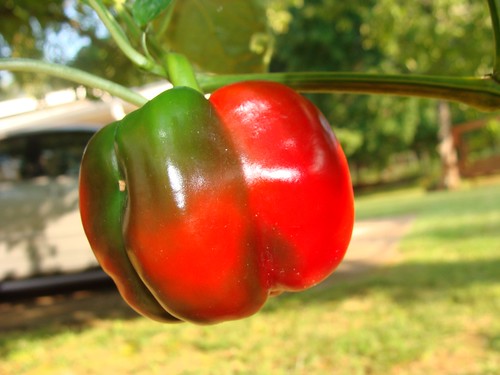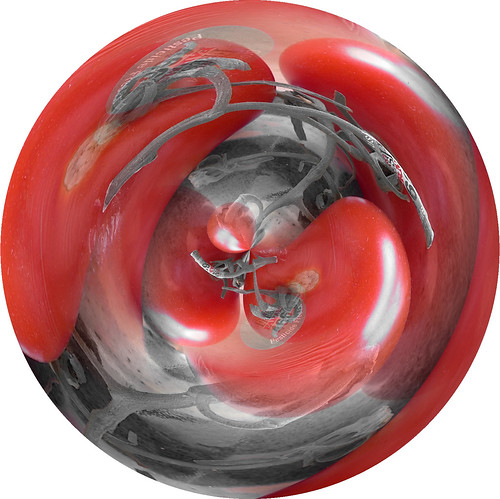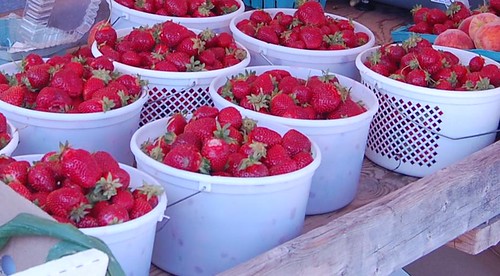Bell pepper, with both green and red colors, natural color by Martin LaBar
My parents’ farm was small. They raised the usual crops that everyone in the area who wasn’t a chicken farmer raised. And some of the chicken farmers also had small farms that raised the usual crops – tomatoes and strawberries were the basics for sale. These were called truck farms because farmers could truck the produce to the big cities- in our case it was Manhattan or Philadelphia- to try to sell. Or we would truck the produce to the canneries that were in our county. Ritters and Seabrook Farms were the two big tomato purchasers. These companies made ketchup and canned tomatoes.
Canned tomatoes by Unhindered by Talent
There were a lot of truck farms. That was why New Jersey was given the name The Garden State. Competition was fierce so the prices for the harvest was usually low. If everyone raised tomatoes and the season was good, the tomatoes were plentiful and the price the farmer got was low. Those years we had tomato fights. My mother canned a lot of tomatoes.
strawberries by Donald Lee Pardue
My mother started her own farm stand. Mostly she sold strawberries and flowers. Neighbors copied her. There were so few cars on the road in those early days that the farm stand did not bring in much money. What little was brought im, though, was greatly needed and appreciated. What didn’t sell became strawberry jam.
When the original farmers got too old to farm or had to give up farming to go to work in the factories where they got a steady income, some of their sons decided to give farming a try. But they decided that owning a small farm could not bring in the necessary income, so they rented the old people’s land for more acreage. And some of these young farmers were clever in that they decided they would try other crops, crops that were new to the market.
One year the people who rented my neighbor’s field decided to grow green bell peppers. This was an unusual vegetable to grow in those areas as a cash crop. The peppers had to be green to be sold to the markets; so when the peppers ripened and became red, they were no longer harvested by the farmers. Then the neighbors were allowed to pick and eat them or else they would be left to rot. We laughed that we were getting the ripe peppers- green bell peppers are the unripe stage; they turn red when fully ripe. Today we now see red bell peppers in the market and know that they are the sweetest form- as well as the most expensive.
One year that young farmer really became clever and decided to plant a very unusual vegetable plant for the market. The kid who rented my neighbor’s land planted bok choy. We never heard of bok choy let alone knew what to do with it. When we were told we could take some, we tried it but couldn’t figure out how to use it. Today there are so many different fruits and vegetables in the market and so many more cookbooks telling you how to use the produce.
One summer the young man who rented our farm planted turnips. I don’t know how he expected to make any money from turnips unless he planned on selling the harvest to pig farmers. It turns out that NJ is a big grower of the turnips sold in the markets today. I don’t think the guy who planted the turnips on our property sold much of his crop of turnips. But it turns out that my mother knew how to use turnips. Turnips have been cultivated since since prehistoric times and humans and animals eat them- both the root and the turnip leaves are edible. See here. Because the turnips weren’t sold, they were left in the ground over winter. When turnips are left in the ground in the winter, after a frost they become sweeter. So it turned out that my parents enjoyed many turnips that year. Turnips are quite nutritious. See here.
Now I come to our present times when people are going back to small farms and making the best of both type of farming- small farms but with unusual plants. This Small Farm Movement is bringing in extra money for people in these tough financial times. The small farm movement is celebrating its 20th anniversary this year. See here. People are raising what I call boutique foods that they can sell to local restaurants. What chef wouldn’t want his own fresh supply of a specialty hot pepper or unusual herb? Or a small farmer can set up a stand to sell at the local weekly farmer’s market. Most shoppers are eager for the freshest produce they can get. And if it is organic, that is an even bigger plus.
Being a farmer isn’t easy but it gives a person a great deal of satisfaction to harvest what one has planted. So if you have some sunny land, consider planting something that will bring in some extra pocket change, as my mother did with the strawberries. Check around with local stores or restaurants to see if there is some fruit or vegetable that you could raise locally that they might want to serve or sell. Get a contract to sell it to them when you harvest it.
But if you don’t want to raise food to sell, but do raise vegetables and have a banner crop, consider donating the excess to your local food bank or soup kitchen.



